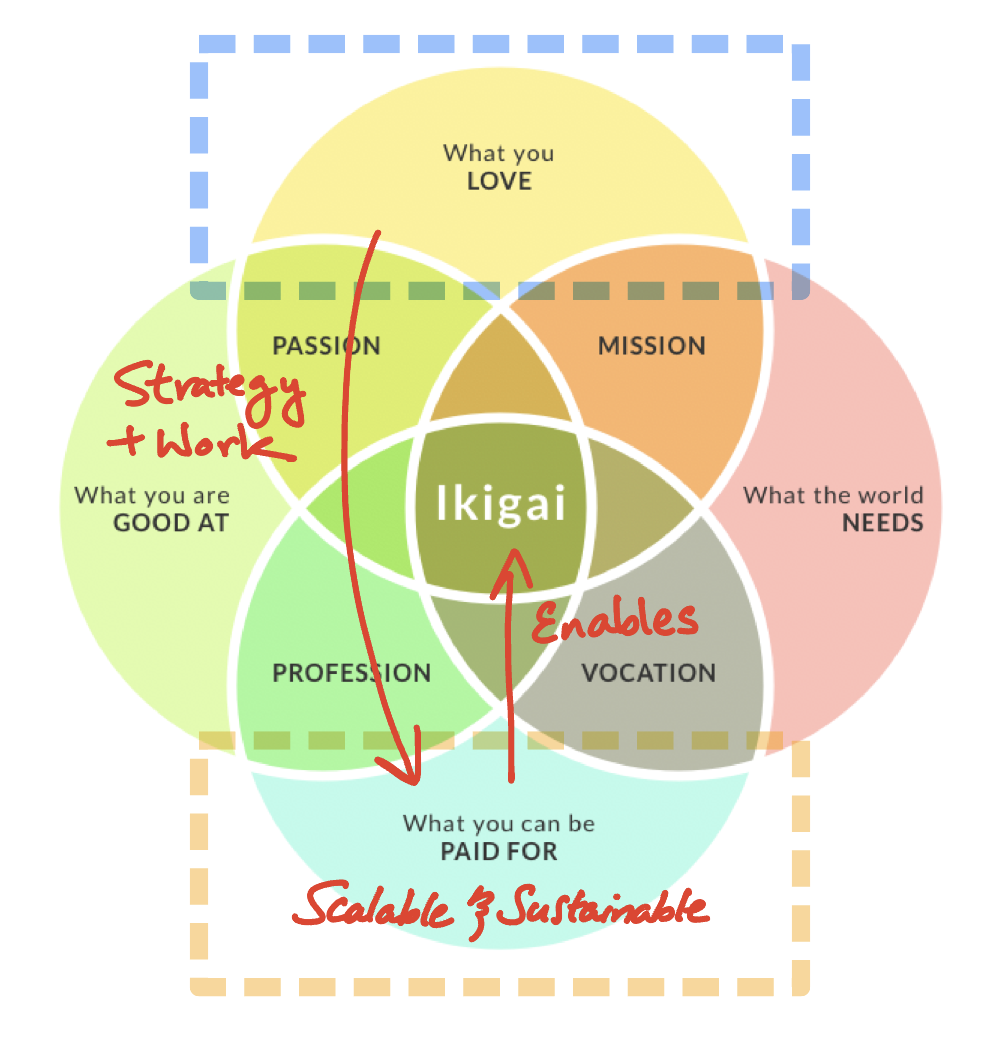Finding Your Ikigai Zone
I was shown this familiar Venn diagram during a recent Mind Map Nation meetup:
It’s Ikigai, or “reason for being” in Japanese. It’s the point where a person's passions, skills, and values intersect with the needs of the world. The idea is that having an Ikigai brings a sense of purpose to our lives, which research suggests is a strong contributor to health and lifespan.
It occurred to me that I’ve arrived in that elusive center as a creator:
I love mind mapping, and have become good at it through years of practice in my career and inner work. During the pandemic, I discovered that the world also needed these tools thanks to YouTube. And now I’m getting compensated to coach folks and bring together other brilliant thinkers in MMN.
All this merges my passion with vocation, profession with mission to form my Ikigai.
But getting to and staying here is anything but straightforward. Here are my two major lessons.
Ikigai Isn’t Static
Ikigai isn’t a permanent state or even a destination, but rather a shifting zone dependent on our emotions and circumstances, which inevitably change over time.
When I wasn’t getting paid for my work in the early days, I was driven by Passion and Mission. When I don’t feel like creating, YouTube and writing become a Profession and Vocation.
Ikigai Isn’t Static
Ikigai isn’t a permanent state or even a destination, but rather a shifting zone dependent on our emotions and circumstances, which inevitably change over time.
When I wasn’t getting paid for my work in the early days, I was driven by Passion and Mission. When I don’t feel like creating, YouTube and writing become a Profession and Vocation.
2020-2022 when I was just putting myself out there and seeing what resonated with my audience. 2. I began to take my passion much more seriously once I began my coaching practice. MMN’s launch further zoned me into my Ikigai.
My Ikigai shifts towards the lower half when I’m heads down building my business and content system, which makes what I do more scalable and sustainable. This then allows me to focus on activities that I love and expresses my passion or mission.
Similarly, one of our MMN members has a day job to pay the bills, but his love and talent is in photography. He’s in the process of getting clients and making his passion into a vocation. When that happens, photography effectively becomes his Ikigai.
Ikigai also changes as we age. Take the late Kobe Bryant who transitioned from winning NBA championships to taking home Academy Awards. Or my friend Larry who bagged an astounding 60 patents during his illustrious career at HP. He retired and found new meaning by funneling his passion for invention into marquetry and building hot rod trucks from scratch.
Seeing Ikigai as a moving target is part of aging gracefully and adapting to life’s changes.
Diversify Your Ikigai
Just as it would be unfair to expect one person to provide all our relationship needs, it’s unrealistic to expect our jobs, which only occupies part of our waking hours, to be our sole source of meaning.
A good friend of mine recently confessed to me that she has no hobbies. She invested so much into her career that she didn’t have the chance to cultivate other interests. This is a fragile state because if something were to disrupt her ability to perform her job, then her entire well of meaning and money would disappear.
I’d challenge us to see our lives as a holistic Ikigai Zone distributed across several “Border Activities” that fulfill different parts of our lives, rather than concentrated in one area.
So if you have a day job and love photography, you don’t have to give up your salary to become a pro photographer. You can have both. The key is to shift your hobby towards the lower half (aka side hustle territory) because getting paid for what you do is part of being a professional artist. Money is just another form of appreciation. Speaking from experience, this financial pressure actually makes us more focused, accountable and creative.
Simultaneously, ensure that your day job doesn’t burn you out and interfere with other border activities by finding fulfilling work that engages you. It doesn’t have to be the mythical Ikigai - just enough to grow your side hustle’s runway.
Prioritizing balance between our jobs and interests on this holistic Ikigai diagram makes us much stronger and adaptable people.
Find Your Ikigai Zones
Finding your Ikigai can be daunting. I personally use mind maps and 2-week sprints to break things down into simpler steps. Here is a decision map to guide you through the process:
If you have no idea what your Ikigai looks like, then I recommend giving my Empowering Mind Maps program a shot. The Possibilities, Priorities and Fun Maps are particularly good self discovery exercises for Ikigai.
If you’re fairly certain of your Ikigai, but need a nudge to get going, I recommend breaking it down into smaller sprints with SMART (specific, measurable, actionable, realistic, timeframed) goals. This might mean for the next two weeks, you’ll commit to shifting your job or hobby towards a certain direction on the diagram.
Some immediate actions could be signing up for an online course, networking to find clients or planning conversations with your boss to make your day job more fulfilling and sustainable. The key is to focus on just the next two weeks rather than starring down the barrel of an intimidating long term project.
The Art of Intentional Living
Just remember that Ikigai is a dynamic, constantly evolving intersection of our passions, skills, values, and external needs. When we’re operating within its zone, we feel a sense of purpose and fulfillment beyond the transactional nature of our day jobs.
However, even when we find it, Ikigai isn’t static and instead changes over time, making it wise to diversify our sources of meaning across several Border Activities. A balanced approach to developing financially sustainable Ikigai is to shift our passions towards monetization while finding fulfilling work that funds our side hustle’s runway.
I wish you the best in discovering your own Ikigai zone.
I’d also love to know:
What areas of your life make up your Ikigai zone?
How can you make your job more fulfilling and/or grow your side hustle to be financially sustainable?
Tweet or DM me on Twitter / Instagram @shengsilver.
Make the most of your mind maps
Thanks for reading this article. If you found it useful, you can get a new mind map in your inbox every week. Epiphany is your dose of structured thinking and ordered chaos.



